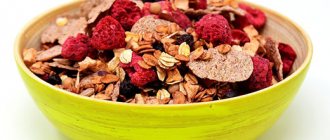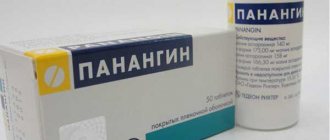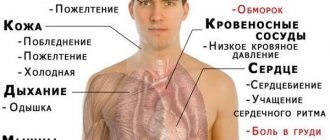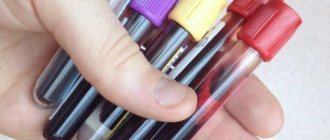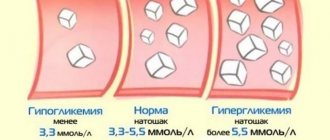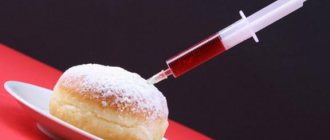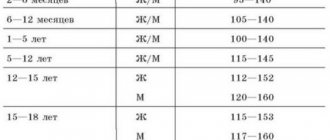The human body contains a very small amount of iron - only about 5 grams. However, its significance for humans is invaluable.
A reduced or increased amount of a microelement will immediately affect the well-being and functioning of all organs and systems - which is why it is so important to know which foods contain iron.
Iron in the human body
Iron is one of the main chemical elements found in the body. Homeostasis—the constancy of the internal environment—depends on it.
Iron is a component of hemoglobin in the blood and is involved in supplying oxygen to all cells and tissues, simultaneously ridding them of harmful carbon dioxide.
Red blood cells - erythrocytes - will not be able to perform their functions without it.
Important! The total iron content in the blood should not exceed 2.4-4.5 grams.
Iron is involved in protecting the body:
- supporting the immune system,
- gives strength to bone tissue,
- supports the functioning of the pancreas,
- normalizes blood circulation,
- stimulates physical activity,
- participates in the synthesis of hormones and energy metabolism of cells,
- helps the liver filter harmful substances,
- supports the normal functioning of the nervous system.
The main source of iron is certain foods.
It is found in both animal and plant foods, but there is a significant difference in the absorption process: iron, which is found in fish and meat, is very easily absorbed.
Attention! Iron from cereals, fruits, legumes and other plant foods is considered difficult to digest.
Softened food rich in iron enters the upper digestive tract and is exposed to gastric juice in the stomach.
Complete absorption of the substance occurs in the duodenum. After this, it enters the blood, where it binds to proteins and is transported to organs and tissues.
The role of iron in the human body is described in the video:
Medicinal properties of products and recipes
Some foods have special healing effects that help cope with anemia.
Chocolate for anemia
Dark chocolate is also an iron-containing product. Contains calcium, potassium, phosphorus, B vitamins. Positive effect: normalizes blood circulation and blood pressure, improves memory and psychological well-being. White chocolate is not as healthy. The product is high in calories and promotes fat deposition. Therefore, it is recommended to limit yourself to 30 grams per day.
Chocolate oatmeal
By combining oatmeal, chocolate and banana, you can make a quite tasty and healthy dish. To prepare, take 5 tablespoons of flakes, pour them into boiling water and cook for 5 minutes. Turning off the heat, leave the pan with the porridge covered with a lid for 15 minutes. First, add half of a banana, mashed to a pureed consistency, into the oatmeal and mix; the second half can be cut into pieces and placed on a plate with the finished dish as a decoration. Then coarsely grated chocolate is added to the porridge - it can be replaced with cocoa powder (1 tsp). Additionally, oatmeal can be sprinkled with sesame seeds or ground walnuts. This will only make the porridge healthier and more appetizing.
Oatmeal with chocolate
Bee bread for anemia
Beebread is pollen, a product accompanying honey in bee combs. Contains vitamins (mainly B and C), organic acids, mineral salts. The product is useful because it quickly normalizes blood composition. As a remedy, you need to take a mixture of 1 tbsp daily. l. honey and 20 g bee bread. The recommended course of treatment is three weeks.
Walnuts for anemia
In addition to iron, they also contain other active elements: calcium, potassium, magnesium, phosphorus, as well as vitamins and omega-3 unsaturated fatty acids.
Interesting fact! By consuming 20-40 g of walnuts daily, you can help the body restore normal hemoglobin levels.
Nutritionists advise including nuts in dishes with other healthy foods, such as green beans. To boiled, fried beans (500 g), in addition to nuts, add chopped onions and fried until golden brown. Additional ingredients may include garlic (1 clove), coriander and sunflower seeds. They can be chopped in a blender along with nuts. Beans with added ingredients are salted to taste, seasoned with olive or sunflower oil and lemon juice (one tablespoon each). Before serving, it is recommended to let the dish sit for 20 minutes.
Beetroot for anemia (recipe)
Beetroot is one of the first vegetable crops included in the diet for iron deficiency anemia. You can drink beetroot juice regularly, including as part of nutritional mixtures. According to one of the recipes, it is mixed in equal proportions with blackcurrant juice. For one glass of this cocktail, add a teaspoon of agar-agar algae jelly. After allowing the mixture to brew for half an hour, it is placed on low heat, where it should boil. After this, the product is poured into molds and left to harden in the refrigerator.
Beetroot jelly
Grocery list
Iron comes from the diet you eat, so consuming too much or too little of iron-rich foods can be harmful to your health. Both deficiency and excess of iron will not bring anything good: a small amount of the microelement can cause serious diseases, and a large amount leads to problems with the liver, endocrine system and heart.
Important! Most of the iron comes from animal food.
Below are some iron-rich foods that you should eat if you have anemia.
Animal sources
Its animal sources:
- Meat (rabbit, beef, turkey, pork, lamb, chicken);
- Liver;
- Egg yolk and eggs of any bird (chicken, quail, ostrich);
- Mackerel, pink salmon;
- Oysters and snails, clams and shrimp, caviar, mussels and other seafood.
Food of animal origin contains so-called heme iron.
Its digestibility reaches 15-35%. The “leader” in microelement content is pork liver (20.2 mg/100 g of product).
Reference! The darker the meat, the more iron it contains.
Plant based sources
- Walnuts, seeds, peas, beans, lentils, beans;
- Cereals (buckwheat and oatmeal, rye, wheat) and bread;
- Dried fruits;
- Tomatoes, beets, celery, pumpkin, cauliflower, broccoli;
- Corn, asparagus, spinach;
- Pomegranate, persimmon, plum, apples.
Plant iron is called non-heme iron . It is absorbed only in an amount of 2-20%. The most microelement is present in wheat bran (11.1 mg/100 g).
The video shows foods rich in iron:
Table of iron rich foods
When determining the dietary value of individual foods, it is important to know which vegetables and fruits increase hemoglobin in the blood.
| Name | Iron content (mg) per 100g | Percentage of daily requirement |
| Quince | 3 | 20 |
| Pears | 2,3 | 16 |
| Cauliflower | 1,4 | 9,8 |
| Cilantro | 1,8 | 13 |
| Sea kale | 16 | 114 |
| Sea buckthorn | 1,4 | 10 |
| Beet | 1,4 | 10 |
| Persimmon | 2,5 | 18 |
| Prunes | 3 | 20 |
| Apples | 2,2 | 16 |
| Black currant | 1,3 | 9 |
Even with a relatively low level of iron, it is in optimal combination with vitamins, which makes it easier to absorb. Cereals, legumes, and nuts can also be a good source
| Name | Iron content (mg) per 100g | Percentage of daily requirement |
| Sesame | 16 | 114 |
| Morel mushroom | 12 | 85 |
| Lentils | 12 | 85 |
| Buckwheat | 8,3 | 60 |
| Sunflower seeds | 6,1 | 44 |
| Peanut | 5 | 36 |
| Basil | 3,2 | 23 |
Beef meat contains 2.7 mg, and chicken meat 1.6 mg of this mineral. There is about 1 mg of iron in fish, and up to 5 mg in seafood.
What is iron deficiency anemia?
Iron deficiency in the body can manifest itself in different ways - from pale skin to anemia. This is a disease in which hemoglobin molecules stop forming. According to statistics, about 70% of all clinical cases are attributed to this type of anemia.
The consequences of iron deficiency anemia are very serious: an insufficient amount of oxygen is carried in the bloodstream, resulting in problems with all organs, tissues, as well as hair and skin.
Anemia develops gradually: initially the body experiences a slight lack of iron, then sideropenia, or iron deficiency, appears.
Important! Sideropenia occurs in 3.6 billion people in the world, but far fewer people know about it.
Pregnant women and adolescents aged 12 to 17 years are more susceptible to the disease. In old age, the frequency of occurrence in men and women is approximately the same. Infants and children born in multiple pregnancies also suffer from iron deficiency.
What is iron deficiency anemia, what are its causes, symptoms and treatment methods is described in the video:
Diet for anemia: diet for children
In children, manifestations of anemia include impaired concentration and intellectual disorders. Therefore, it is important to promptly determine the cause and begin treatment of the disease.
A severe degree of the disorder requires specialized treatment, the administration of iron supplements in the form of drops, suspension, or syrup. Injection therapy is rarely prescribed; it is associated with maintaining the state of certain diseases.
For mild anemia, a diet rich in iron is recommended. The diet should contain sufficient vitamin B12 (meat, eggs, milk), folic acid (leafy vegetables), vitamin K (given in the form of drops for infants under 6 months of age). It is important to consume vitamin C with food (it is usually present in the diet in sufficient quantities - its deficiency causes bleeding).
Anemia in adolescent girls may be associated with significant blood loss during menstruation. The risk of excessive weight control through inappropriate “dietary” restrictions cannot be ruled out (remember that the diet for anemia in children and adolescents is balanced and does not involve fasting!).
Causes and symptoms
The causes of iron deficiency in the body include:
- Poor nutrition;
- Diseases of the digestive system;
- Major blood loss, for example due to trauma;
- Increased need for iron.
A special risk group is women during pregnancy and newborn children. While the baby is in the womb, he receives iron from her body. Accordingly, the mother’s body lacks it.
When a baby is born, breast milk becomes the source of iron for him, but there is very little of it or none at all, because all the mother’s iron has already been absorbed by the baby while in the tummy.
Reference! Anemia occurs in a large number of people, but not everyone knows about iron deficiency in their body.
Symptoms of sideropenia:
- Dry skin;
- Brittle nails, prone to splitting and brittleness;
- The appearance of transverse whitish lines on the nails;
- Slow hair growth, split ends;
- General weakness, fatigue, chronic fatigue syndrome;
- Permanently pale skin color;
- Taste perversions: desire to eat chalk, toothpaste, paints, etc.;
- Aversion or, on the contrary, a strong craving for smells;
- Redness, irritation and peeling in the corners of the mouth;
- Dizziness, loss of consciousness, shortness of breath;
- Irritability.
To increase hemoglobin
Hemoglobin is the main component of red blood cells. It would seem that in order to increase hemoglobin, it is enough to simply introduce foods high in iron into the diet. However, quantity does not always mean quality.
The fact is that it is necessary not only to increase the proportion of microelement consumed, but also to improve its absorption. The main factors that influence this parameter are the acidity of gastric juice, the condition of the intestines and the presence of certain substances in it.
Attention! It is useless to pump the body with “pure” iron: in this case, it will take much longer to increase hemoglobin.
However, there are products that will help you do this faster, more efficiently and better, these include:
- Beef;
- Chicken meat;
- Turkey;
- Eggs;
- Liver;
- Carrot;
- Potato;
- Cabbage, broccoli, cauliflower;
- Pumpkin;
- Tomatoes.
The video describes products that help raise hemoglobin:
Sample menu
For anemia in adults and children, it is important to properly draw up a nutrition plan for every day.
To diversify your diet, you can use the following scheme: Monday
| Breakfast | A piece of bread with butter, a salad of radishes and sweet peppers, tea with milk, cottage cheese with sour cream, a slice of fillet sausage. |
| Snack | Butter bun, fruit juice. |
| Dinner | Meat broth with noodles, boiled meat and potatoes, tomato salad, orange juice, strawberry jam, a slice of bread. |
| Afternoon snack | Cookies, a glass of milk. |
| Dinner | Omelette, green peas, a piece of bread with butter, tea. |
| 2 hours before bedtime | Small apple. |
Important information: How to treat anemia in an infant (infant) and why it is dangerous in children under one year of age (newborns)
Tuesday
| Breakfast | Scrambled eggs, coffee with milk, a slice of bread with butter, vegetable salad. |
| Snack | Bread with butter, baked fish, tea. |
| Dinner | Beetroot soup, puff pastry pies, boiled beef liver, buckwheat, radish salad with sour cream, pear in sweet sauce, vegetable juice, bread. |
| Afternoon snack | Chicory drink, cookies. |
| Dinner | Vegetable salad with sour cream, bread with a slice of ham, tea. |
| 2 hours before bedtime | A glass of kefir. |
Wednesday
| Breakfast | Semolina porridge with butter, cheese, coffee with milk, bread. |
| Snack | Boiled chicken meat, cucumber, bread, tea. |
| Dinner | Borscht with meat, boiled potatoes, cabbage salad, whipped cream with cherry jam, juice, bread. |
| Afternoon snack | Cocoa, butter bun. |
| Dinner | Vegetable or fruit juice, pancakes with cottage cheese and fruit jam. |
| 2 hours before bedtime | Pomegranate. |
Thursday
| Breakfast | Boiled egg, ham, coffee with milk, bread and butter, biscuit. |
| Snack | Buckwheat with butter, vegetable salad, dried fruit compote. |
| Dinner | Pea soup, baked meat, stewed vegetables, fresh fruit, juice, bread. |
| Afternoon snack | A glass of milk, cookies. |
| Dinner | Mushroom cutlets, berry juice, bread. |
| 2 hours before bedtime | Rose hip decoction. |
Friday
| Breakfast | Noodles, cottage cheese with sour cream, bread with butter, tea with milk. |
| Snack | Fish pudding with butter sauce, fruit juice, bread. |
| Dinner | Rassolnik with meat, beef, stewed zucchini, fruit jelly, apple, vegetable juice, bread. |
| Afternoon snack | Cocoa, butter bun. |
| Dinner | Fish in dough, bread, jelly. |
| 2 hours before bedtime | Yeast drink. |
Important information: How to treat chronic anemia
Saturday
| Breakfast | Schnitzel with breadcrumbs, vegetable salad, bread, fruit juice. |
| Snack | Fried potatoes, boiled egg, fruit, coffee with cream, bread. |
| Dinner | Borscht with meat and sour cream, steak, cake, carrot juice, apple. |
| Afternoon snack | Tea with milk, a bun. |
| Dinner | Semolina pancakes with jam, milk. |
| 2 hours before bedtime | A glass of curdled milk. |
Sunday
| Breakfast | Potatoes with liver pate, bread and butter, vegetable salad, coffee with milk, fruit. |
| Snack | Boiled egg, fermented baked milk, bread. |
| Dinner | Vegetable soup with sour cream, tomato salad, pilaf with fruit and lamb, juice, bread. |
| Afternoon snack | Tea with milk, cookies. |
| Dinner | Boiled chicken breast, cheesecakes, milk. |
| 2 hours before bedtime | Rose hip decoction. |
For anemia in women, the diet should include a large amount of useful substances, including vitamin B12.
Folk remedies
Taking folk remedies is an auxiliary and very effective measure for replenishing iron in the body in combination with a balanced diet and drug treatment. Each method of traditional medicine must be agreed with a doctor.
Nettle helps fight iron deficiency anemia:
- It purifies the blood and has hemostatic properties.
- The juice of the plant has the greatest power - just 1 teaspoon of nettle juice is dissolved in 50 ml of water and taken three times a day, regardless of meals.
Rosehip is effective both in its pure form and in the form of tea. Rose hips are crushed (can be mixed with black currants), poured with boiling water and allowed to brew. 4 cups of this drink a day perfectly replenish iron reserves in the body.
Reference! An infusion of rose hips and wild strawberries helps well.
A pulp of dried fruits - raisins, dried apricots, prunes and figs - has not only healing properties, but also a pleasant taste. A small amount can be consumed in pure form, added to oatmeal, or spread on bread or pancakes.
Basic rules of therapeutic nutrition for low hemoglobin
Iron consumed in food is not 100% used by the body. Its losses can be reduced to some extent by using the right methods of cooking and taking nutritional supplements.
Basic rules of diet for iron deficiency anemia in adults and children:
- Iron utilization from raw vegetables is lower than from briefly boiling or sautéing. When consuming raw broccoli, it is used 25% less than when eating cooked vegetables.
- Fruits are best consumed raw (except peaches).
- Iron is better absorbed from roasted nuts and sprouted seeds.
- To prepare yeast dough, it is preferable to use whole grain flour.
- Acid supplements increase the body's use of iron by up to 4-5 times. It is also advisable to use them to reduce the glycemic index (GI) of carbohydrate foods.
- Legumes should be pre-soaked - this will improve the use of iron and the digestibility of food.
- Oatmeal has a low GI and is a source of iron. It is recommended to consume it with milk or water. Boiled flakes have a higher GI, which increases blood glucose levels.
Some useful tips regarding diet for iron deficiency:
- Eliminate alcohol from your diet, reduce coffee, and strong black tea.
- Drink water instead of milk, but don't cut it out completely.
- Season vegetable salads with citrus juice or add orange to them.
- Provide your body with a varied, balanced diet that contains essential nutrients from both plant and animal sources of iron. This will provide his daily needs.
What to Focus on When Dieting for Anemia:
- on iron consumption, suitable food combinations;
- on foods that increase its use;
- on food that slows down its absorption.
To successfully treat anemia, it is important to determine the cause of the disease. Anemia can also be a sign of a number of diseases (chronic inflammation, long-term gastrointestinal disorder). Therefore, if symptoms appear, consult a doctor.
For pregnant
During pregnancy, you need to consume twice as much iron - for yourself and for the baby. Experts recommend increasing the amount of microelement to 30 mg per day at this time.
Reference! The peak iron requirement occurs between 8 and 22 weeks of pregnancy.
How to compensate for iron deficiency during pregnancy?
- Dietary red meat, eggs, lean fish, seafood (especially shellfish);
- Fried liver (only in the 2nd and 3rd trimesters!);
- Nuts, legumes and whole grains, cereals, and oatmeal can be consumed every day;
- Bananas, pears, persimmons, apples, pears, plums, apricots;
- Dried fruits (in particular dried apricots);
- Natural red juices (cherry, pomegranate, grape);
- Beets, fennel and dark green vegetables (spinach, peas, broccoli).
Important! Iron is better absorbed when exposed to vitamin C, so adding fresh lemon juice to your dishes will be beneficial.
Is it dangerous to reduce hemoglobin in pregnant women? This video explains:
Recommendations for preparing a diet
How to properly create a menu for a patient with anemia in order to get maximum benefit and enjoy the taste? Nutritionists advise dividing the daily diet into 5 meals. To build a daily menu, use our tips:
- breakfast cannot be skipped. Please yourself and your family with crumbly buckwheat porridge, chicken liver, and vegetable salads. Cranberry juice or berry compote are perfect drinks;
- For a snack at the office, take apples, nuts, dried fruits or a boiled egg;
- For lunch, prepare soup or broth and a meat dish: chicken fillet with vegetables, stewed lamb, boiled veal. Dessert can be fruit salad;
- low-fat cottage cheese with honey is an excellent option for a light afternoon snack;
- dinner should be low-calorie and healthy. We recommend baked fish; this dish will perfectly complement a salad of fresh tomatoes and herbs.
When creating a menu for every day, control the ratio of proteins, fats and carbohydrates. Combine dishes in such a way that the body is guaranteed to receive iron, folic acid, vitamins C, B. When forming a diet with a predominance of protein foods, do not forget about fiber: cabbage, celery, carrots, beets, tomatoes, greens will help the functioning of the gastrointestinal tract, cleanse body and ensure excellent absorption of nutrients.
What affects iron absorption?
The concentration of iron in the body is affected not only by foods rich in it, but also by the combination of foods consumed. Components that help iron be better absorbed can be obtained not only from food, but also taken additionally in the form of vitamins.
The bioavailability of iron is increased by:
- Ascorbic acid, the content of which is high in rose hips, cauliflower and bell peppers;
- Copper contained in liver, buckwheat and peanuts;
- Folic acid in beef liver, cod liver and walnuts;
- Citric and malic acid (citrus fruits, tomatoes, peppers);
- Sulfur-containing amino acids in products of animal origin (meat, fish, seafood);
- Sugar.
The reverse function is performed by:
- Calcium (dairy products);
- Phytates (bread, legumes);
- Milk and soy proteins;
- Tannin (tea, coffee, pomegranate, persimmon);
- Phosphates (canned food, processed cheese, carbonated drinks).
How to determine a deficiency in the body?
Initially, you should focus on the signs that were indicated above.
If you find them in yourself, you need to visit a therapist. His task is to examine the patient and take an anamnesis, as well as write a referral for a general blood test.
Reference! Iron deficiency in the body can only be determined through laboratory testing.
The analysis shows the level of hemoglobin, after which the iron content in the blood is determined. The analysis does not require any special preparation, but blood must be taken on an empty stomach from 8 to 11 am. The day before donating blood, you need to provide your body with complete rest: give up alcohol, sports and nervous tension. In a couple of days the tests will be ready.
Hemoglobin is indicated separately on the form. The results obtained are compared with a table according to gender and age and a conclusion is made about the norm or deviation from it.
In medicine, iron deficiency is classified into three stages.
1. Prelatent deficiency.
When a person has a deficiency of ferritin, a water-soluble glycoprotein complex, this is an alarming sign, although the iron content in the blood is normal. The symptoms do not bother the patient at all.
2. Latent deficit.
If no measures were taken at the first stage, or no diagnosis was made at all, the next stage begins. It is already characterized by some clinical signs:
- lack of muscle tone,
- fast fatiguability,
- excessive dryness of the skin,
- hair thinning,
- change in taste preferences towards spicy foods with lots of seasonings.
When determining this stage, an additional laboratory test is required for TIBC - the total iron-binding capacity of blood serum;
3. Iron deficiency anemia (anemia).
The diagnosis is made if the body is severely deficient in iron or has frequent surges, i.e. With each decrease in concentration, the amount of the microelement is not replenished.
The disease includes signs of anemia and iron deficiency in tissues.
Attention! This stage is divided into two stages - hidden and obvious anemia.
Symptoms begin to bother the patient already at the first stage:
- general malaise appears,
- weakness,
- unpleasant sensations in the mouth (dryness, burning, unusual smell of acetone),
- arrhythmia,
- dyspnea.
As it progresses, other signs are added, more obvious: hair loss, gray hair, sagging and pale skin, sometimes with a greenish tint, deterioration of the nails (layering, brittleness, concavity), frequent headaches and dizziness, drowsiness, absent-mindedness. The person may suddenly lose consciousness.
The longer the disease develops, the more noticeable and severe the symptoms.
If the analysis shows iron deficiency, an additional biochemical blood test is prescribed. It helps confirm the diagnosis of iron deficiency anemia.
Reference! Sometimes, with iron deficiency, the symptom of “blue sclera” appears. The white membrane of the eye, which is usually seen as white, takes on a blue tint.
Once the diagnosis is made, appropriate treatment is prescribed.
The video describes the symptoms of iron deficiency in the body:
What reasons lead to the decline?
There are many reasons for iron deficiency and, as a rule, one is enough to make a diagnosis of iron deficiency anemia.
Main causes of anemia:
- The first and main reason is the lack of iron-containing foods. Surely many people will prefer pork kebab to chicken liver, and banana to spinach. Refusal of healthy food day after day is a sure path to diagnosing anemia.
- Incompatibility of products. Another prerequisite for the occurrence of iron deficiency is the introduction into the diet of both iron-containing foods and those that will not allow it to be fully absorbed. For example, drinking liver or eggs with tea is the same as nullifying their beneficial properties. A combination of iron and calcium, for example, buckwheat with milk, gives the same effect.
- The body's inability to absorb iron. This violation has its reasons. Iron absorption occurs in the small intestine, and some diseases (for example, dysbiosis) prevent this.
- Active growth of the body. During childhood and adolescence, all organs and tissues need large amounts of iron, which makes it necessary to consume even more iron.
- Pregnancy. As noted above, during these 9 months not only the woman, but also the fetus needs iron. The developing body requires many useful substances and microelements, so almost all of the incoming iron is spent on its “construction”. This is why it is so important to monitor your hemoglobin levels at this time.
- Excessive physical activity . Frequent and very active sports activities cause profuse sweating. Along with sweat, iron reserves also come out, so athletes need to replenish them.
- Blood loss. Vascular pathologies, high or low blood pressure, internal bleeding due to various diseases, injuries - all this affects the decrease in the amount of iron in the blood. In addition, regular donation affects the concentration of iron in the blood serum, and in women with heavy periods, the level of hemoglobin changes.
Basic principles of nutrition for anemia
The diet for anemia excludes fasting. Don't rely on untested special diet regimens designed to help you lose weight, even at the cost of your health. Whole grains and cereals are healthy sources of iron. They satiate for a long time, contain fiber, have a low glycemic index, and help with weight loss.
As part of the diet for IDA, include foods containing iron and vitamins B12 and B9 in your diet. It is important to eat a balanced, healthy diet with plenty of vitamins that support iron absorption.
Consequences of iron deficiency anemia
No deficiency or excess leaves its mark on the body, even if we are talking about a substance of which there are only a few grams for the entire adult body.
Lack of iron has a detrimental effect on the mucous membranes and causes their atrophy:
- Consequently, the barrier function of the epithelium is not fulfilled, and the body becomes vulnerable to infections and viruses.
- In combination with reduced immunity, microelement deficiency often leads to gastritis, rhinitis, sinusitis and other diseases.
Weakness of the whole body and rapid fatigue due to iron deficiency are associated with a lack of muscle tone. Muscle disorders are a trigger for myocardial dystrophy and hypotension, tachycardia and heart pathologies. As a result of a lack of iron, organs and tissues do not receive the proper amount of oxygen, hypoxia occurs.
It results in some tangible pathologies:
- performance decreases,
- constant fatigue syndrome appears,
- the patient always wants to sleep,
- feels increased fatigue,
- gets irritated for any reason.
Attention! Plus, due to the lack of an element, the appearance also suffers: nails, hair and skin become unusable in a very short time. Wrinkles, early gray hair, hair loss - all these are consequences of iron deficiency.
Iron deficiency does not have the best effect on the condition of the liver, causing its functional failure. The frequency of colds increases, bone marrow production decreases. The lack of this microelement leads to disruption of the thyroid gland, which, in turn, affects the hormonal background of the body.
In pregnant women, iron deficiency can lead to fetoplacental insufficiency - dystrophy of the placenta and myometrium, which begin to produce less hormones.
The dangers of iron deficiency anemia are explained in the video:
Consequences of not following the diet
Anemia and diet are related, so if left untreated, the disease begins to progress. Low hemoglobin levels and poor dietary intake can cause:
- myodystrophy;
- atrophic processes in the mucous membrane of the digestive tract, respiratory system and genital organs.
With a lack of nutrients, the functioning of the cardiovascular system deteriorates and pathological changes occur in the body. A decrease in immune defense leads to infection and the development of diseases.

